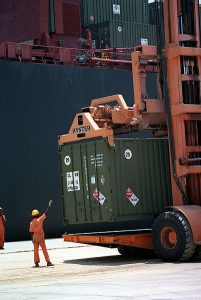A Peek at Peak Season

Dockworker and cargo containers
It’s happening right now! Peak season for the international shipping industry. Or is it?
Traditionally, August and September are huge months for the international shipping industry as U.S. shippers are revving up for the holiday season. This year, the experts have been tapering expectations for the peak season.
August is happening right now, so we won’t find out until next month how this big month of the traditional peak season turns out with numbers on cargo containers of goods moved through the ports. However, there are July numbers and general shipping trends to give us a peek at how things might be looking.
While August and September are the prime months of the peak season, things start revving up in July. July’s numbers usually give an idea of what kind of peak season will be delivered in August and September.
Higher numbers in July, particularly good cargo movement growth, are considered a portend of good things to come through the August and September months of the peak season.
So how did July look?
We already posted on blog on the big numbers over at the Port of Oakland.
The problem with the 8.8% year over year growth the Port of Oakland saw in July is that it was majorly bolstered by empty containers. Many think those empty containers are a sign of cargo about to move through the port in August and September while others explain it with the larger ships now being deployed by carriers.
The twin Ports of Los Angeles and Long Beach are the ones really watched to see how the international shipping numbers are trending in the U.S. since they’re the country’s largest ports in terms of container cargo moved.
July numbers at the Ports of Los Angeles and Long Beach are a mixed bag.
The Journal of Commerce (JOC) posted an article on how the Los Angeles and Oakland import volumes bode well for the peak season. We already talked about the Port of Oakland’s July numbers, but that article also cites that the port of Los Angeles saw a 5.15% year over year increase in imports for the month of July.
On the other hand, American Shipper posted an article reporting a 7.7% decrease at the Port of Long Beach for container volumes in July year over year.
While JOC put the positive numbers of the Port of Los Angeles and the Port of Oakland together to give a positive spin to the numbers, others combined the Port of Los Angeles with the Port of Long Beach for a more tempered outlook.
The Wall Street Journal, in an article on the top supply chain and logistics news, had this to say:
This isn’t the way container carriers have hoped to see the peak shipping season starting. Combined imports into Southern California’s ports of Los Angeles and Long Beach slipped 0.3% year-over-year in July, suggesting that retailers remain cautious about restocking inventories even as consumer sales get stronger.
I would lean more toward the numbers being less than an optimal start for the international shipping peak season in the U.S.
Considering the fact that labor strife at the Port of Los Angeles (and all along the West Coast) because of contract negotiations between the PMA and ILWU was causing shippers to start diverting cargo to the East and Gulf Coasts, even the increases seen could be explained away as a return of lost market share.
The congestion of last year caused many retailers to be leery of depending on the peak season to get holiday goods to store shelves on time, causing shippers to stock up inventories. Now, we’ll have to wait and see if the peak season really looks like the peak season this year.




